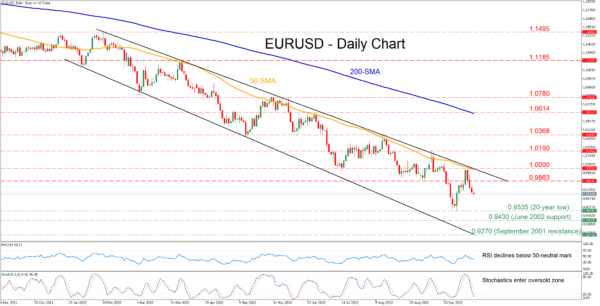EURUSD has been losing ground since the beginning of the year, creating a clear structure of lower highs and lower lows within a descending channel. Although the pair managed to post a moderate rebound after finding its feet at the 20-year low of 0.9430, it quickly retraced back as the 50-day simple moving average (SMA) curbed the upside.
The momentum indicators currently suggest that the negative near-term bias is strengthening. Specifically, the RSI is declining below its 50-neutral mark, while the stochastic oscillator has retreated into the 20-oversold territory.
Should selling pressures persist, the price could initially test the 20-year low of 0.9535. If that floor collapses, the June 2002 support of 0.9430 may then provide downside protection. Failing to halt there, the September 2001 resistance of 0.9270 might prove to be the next tough barrier for the bears to overcome.
On the flipside, bullish actions could propel the price towards the August low of 0.9863, which could now act as resistance. Conquering this barricade, the spotlight may turn to parity, which is considered a crucial psychological mark by markets. Even higher, the bulls could aim for 1.0190 before the August peak of 1.0368 comes under examination.
In brief, it seems that a new round of weakness has started for EURUSD, with the price declining towards its recent lows. For that bearish sentiment to reverse, the price needs to clearly break above its descending trendline.














